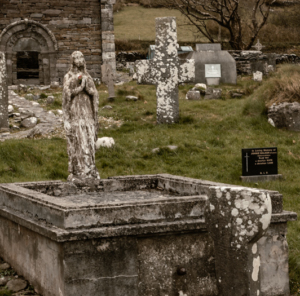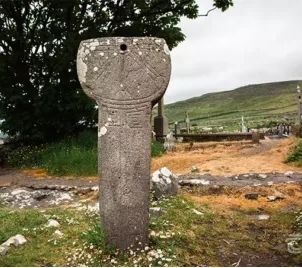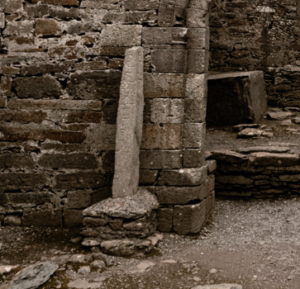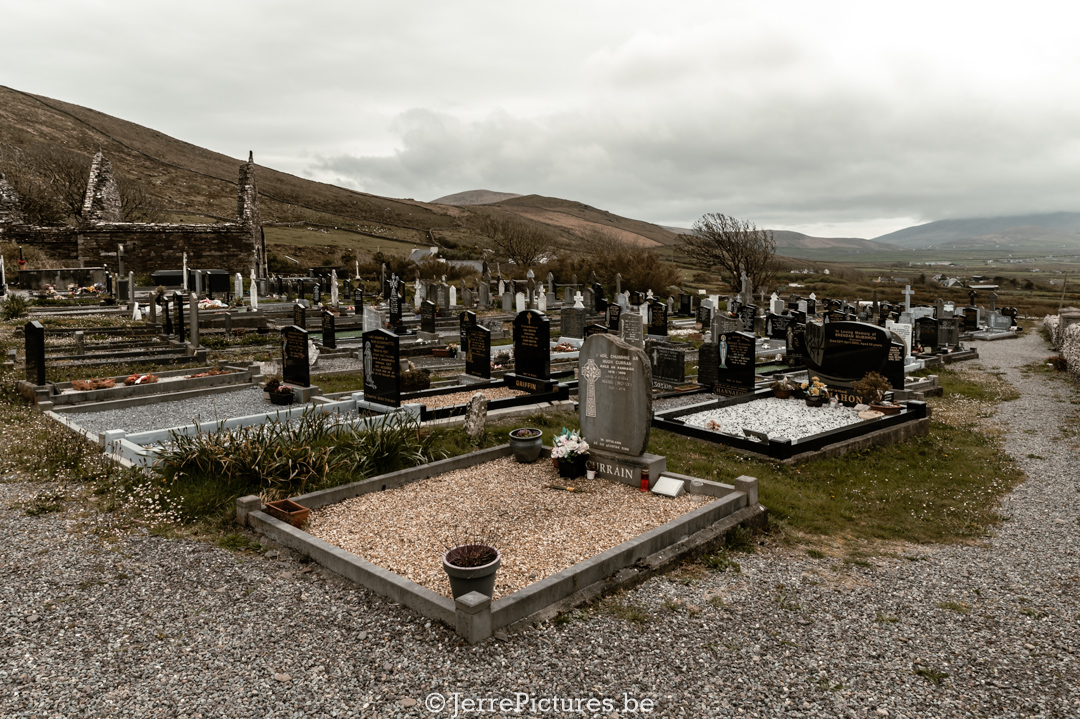Imagine a breathtaking spot in Ireland, steeped in history and spiritual significance, where ancient architecture and enchanting landscapes converge. Welcome to Kilmalkedar, a true gem nestled on the picturesque Dingle Peninsula in County Kerry. Here, you’ll step back in time while soaking in panoramic views of the mesmerizing Smerwick Harbour.
Kilmalkedar gets its name from Chill Maolchéadair, honoring its little-known founder, St. Maolcethair, who passed away in the year 636. Yet, the site is also intimately connected with the legendary St. Brendan the Navigator. As you step onto the grounds, you’ll sense the layers of history and devotion that have accumulated over countless centuries.
The surroundings resemble a living canvas. The majestic church, constructed in the early 12th century, proudly rests on a hill, offering an unforgettable vista of the shimmering Smerwick Harbour. The landscape stretches, with rolling hills merging into the vast Atlantic Ocean. It’s easy to envision this as a destination that beckoned spiritual seekers and pilgrims.
As you explore the sprawling terrain spanning over 10 acres, you’re enveloped by the tranquil presence of ancient stones and artifacts. An Hiberno-Romanesque church, an imposing stone cross, and a mysterious Ogham stone stand as silent tributes to those who once prayed, learned, and sought meaning here. The ‘Alphabet Stone’, positioned beside the beautifully adorned chancel arch, seems to whisper a message from a distant past.
A nerdy deep dive into Kilmalkedar
Inside the church, you’ll uncover the splendor of medieval architecture blended with traditional Irish craftsmanship. A splendid doorway adorns the facade, with patterns reflecting the opulent Hiberno-Romanesque style. Three decorative orders, lavishly adorned with zigzag motifs, frame a human head that appears to watch over the sacred space. The aura of mystery and significance lingers as you wander through the church, with its distinctive projecting antae and thoughtfully designed blind arcades.
Kilmalkedar wasn’t merely a place of worship; it also served as a meeting point for pilgrims who traversed the Saint’s Road (Casán na Naomh), a route leading to the majestic peak of Mount Brandon. The site still exudes an atmosphere of days gone by, with local rituals bearing witness to deeply ingrained spirituality. The act of performing nine clockwise rounds on Easter Sunday and the enigmatic practice of drilling holes into standing stones are remnants of a Celtic religion that may have thrived long before the arrival of Christianity.
Kilmalkedar, with its rich history and significance, takes you on an enchanting journey through time. It’s a place where Irish heritage and spirituality meld into an experience that will remain etched in your memory. As you touch the ancient stones and admire the landscape, you’ll feel the presence of those who once stood and prayed here, serving as a reminder of the timeless quest for meaning and connection.
And while you’re here, there are two must-see attractions you shouldn’t miss:
Ogham Stone: Inside the church stands an Ogham stone, an inscription in an ancient Irish script used during the early Middle Ages. These stones were often used to record names and inscriptions in the Celtic language. This particular stone is believed to date back to the 6th or 7th century, with an inscription that reads ‘ANN MAILE INBIR MACI BROCANN.’

Kilmalkedar Cross Slab: Another striking feature is the Kilmalkedar Cross Slab, a large Latin stone cross adorned with Celtic motifs and Christian symbolism. This cross likely dates back to the 9th or 10th century and serves as evidence of early Christian influence in the area.

The Sundial: Another remarkable feature within the graveyard is a sundial. I’d suggest trying to locate it. The sundial, or surviving sundials, are quite rare on sites from this period. It’s likely from the 7th, 8th, or perhaps 9th century. Moreover, it’s one of only nine sundials from the early medieval period that have survived in Irish graveyards. This sundial was used to tell the time of day, although it may not have been particularly useful given Ireland’s often cloudy weather. Thus, it was more of a luxury product of the time, indicating that the monks who lived here enjoyed a relatively comfortable lifestyle.

The Alphabet Stone: An intriguing artifact that invites speculation, the Alphabet Stone finds its place within the confines of the church, positioned adjacent to the chancel arch. Rising to a height of approximately 1.20 meters, this pillar stone, albeit fractured at its summit, bears testament to its enduring history.
The stone derives its name from the letters meticulously etched upon its surface—DNI, an abbreviation of the Latin term ‘Domini,’ translating to ‘Lord.’ Accompanying these significant letters is a Latin cross adorned with elegantly scrolled terminals, a striking symbol of faith and devotion.
The origins of the Alphabet Stone offer a tantalizing glimpse into the past, potentially tracing back to the remarkable era of the 6th or 7th century. As we stand before this ancient relic, one can’t help but marvel at the hands that carved these characters and the stories they represent. It serves as a tangible connection to an age when craftsmanship and spirituality converged to leave an indelible mark on Kilmalkedar’s landscape.
This stone, with its enigmatic inscriptions, prompts contemplation about its purpose and the individuals who played a role in its creation. Was it a marker of reverence, a touchstone for pilgrims, or a conduit for spiritual contemplation? The Alphabet Stone remains an eloquent witness to a time long past, an enduring testament to the intertwining threads of faith and history that continue to define the essence of Kilmalkedar.

St. Brendan’s House | The Priest’s House: An intriguing edifice that sparks the imagination, St. Brendan’s House, also known as The Priest’s House, sheds light on medieval life in Kilmalkedar. It is believed that this building provided accommodation for the priest during the later medieval period. Presenting itself as a three-story rectangular structure delicately nestled in a charming, enclosed space, framed by lush fuchsia shrubs.
As you explore the surroundings, you’ll uncover a certain mystical ambiance steeped in history and devotion. Notably situated near the building is a small holy spring, named St. Brendan’s Well or Tobar Bréanainn, positioned just above the babbling brook. A modern concrete wall now encircles this well, a contemporary gesture to safeguard its sanctity. Undoubtedly, this spring has drawn pilgrims and visitors for centuries, its presence adding an extra layer of mystery to the enchanting landscape.
An intriguing facet of St. Brendan’s House is the restricted access that lends it an almost enigmatic allure. During my most recent visits, I was met with a locked gate and an imposing sign reading “Keep Out.” Although I could only observe from a distance, this contributed to an aura of secrecy and curiosity enveloping the house. While the present denies us entry into its interior, the building serves as a reminder that the past still whispers in the stones and the air around us.
St. Brendan’s House stands as a captivating witness to times long gone by, a testament to the spiritual and practical needs of the medieval community in Kilmalkedar. While its doors remain closed, it beckons contemplation of the tales it could unveil if it could speak, remaining an enchanting element of the expansive legacy of this historic locale.
note: The church might not be the first one on the site; the earlier church is believed to have originated around the 7th century with Maolcethair, although it has become more associated with St. Brendan in recent times. The cult of St. Brendan likely reached this area around the 9th century. As previously described, this current church dates back to the 12th century (presumably). This church boasts many Romanesque features, starting with the highly ornate Romanesque doorway, which has unfortunately weathered over time.
